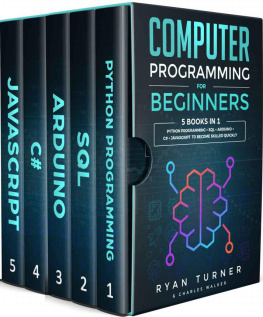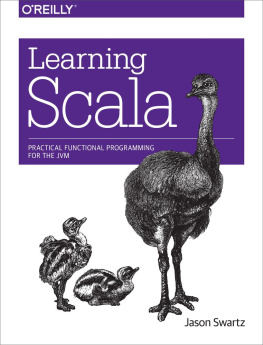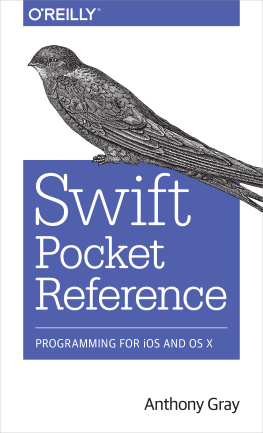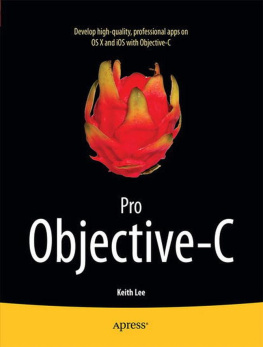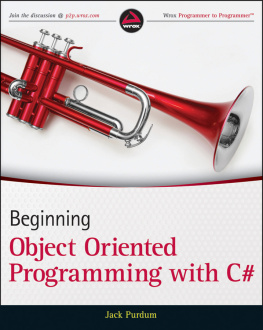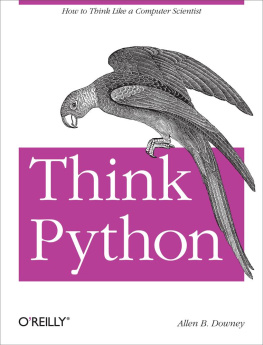C# 4.0: The Complete Reference
About the Author
Herbert Schildt is a leading authority on C#, C++, C, and Java. His programming books have sold millions of copies worldwide and have been translated into all major foreign languages. He is the author of numerous bestsellers, including Java: The Complete Reference, C++: The Complete Reference, and C: The Complete Reference, among many others. Although interested in all facets of computing, his primary focus is computer languages, including compilers, interpreters, and robotic control languages. He also has an active interest in the standardization of languages. Schildt holds both graduate and undergraduate degrees from the University of Illinois. He can be reached at his consulting office at (217) 586-4683. His web site is www.HerbSchildt.com .
About the Technical Editor
Michael Howard is a principal security program manager on the Trustworthy Computing (TwC) Groups Security Engineering team at Microsoft, where he is responsible for managing secure design, programming, and testing techniques across the company. Howard is an architect of the Security Development Lifecycle (SDL), a process for improving the security of Microsofts software.
Howard began his career with Microsoft in 1992 at the companys New Zealand office, working for the first two years with Windows and compilers on the Product Support Services team and then with Microsoft Consulting Services, where he provided security infrastructure support to customers and assisted in the design of custom solutions and development of software. In 1997, Howard moved to the United States to work for the Windows division on Internet Information Services, Microsofts next-generation web server, before moving to his current role in 2000.
Howard is an editor of IEEE Security & Privacy, a frequent speaker at security-related conferences, and he regularly publishes articles on secure coding and design. Howard is the co-author of six security books, including the award-winning Writing Secure Code, 24 Deadly Sins of Software Security, The Security Development Lifecycle, and his most recent release, Writing Secure Code for Windows Vista.
C# 4.0: The Complete Reference
Herbert Schildt


Copyright 2010 by The McGraw-Hill Companies. All rights reserved. Except as permitted under the United States Copyright Act of 1976, no part of this publication may be reproduced or distributed in any form or by any means, or stored in a database or retrieval system, without the prior written permission of the publisher.
ISBN: 978-0-07-174117-0
MHID: 0-07-174117-8
The material in this eBook also appears in the print version of this title: ISBN: 978-0-07-174116-3, MHID: 0-07-174116-X.
All trademarks are trademarks of their respective owners. Rather than put a trademark symbol after every occurrence of a trademarked name, we use names in an editorial fashion only, and to the benefit of the trademark owner, with no intention of infringement of the trademark. Where such designations appear in this book, they have been printed with initial caps.
McGraw-Hill eBooks are available at special quantity discounts to use as premiums and sales promotions, or for use in corporate training programs. To contact a representative please e-mail us at bulksales@mcgraw-hill.com.
Information has been obtained by McGraw-Hill from sources believed to be reliable. However, because of the possibility of human or mechanical error by our sources, McGraw-Hill, or others, McGraw-Hill does not guarantee the accuracy, adequacy, or completeness of any information and is not responsible for any errors or omissions or the results obtained from the use of such information.
TERMS OF USE
This is a copyrighted work and The McGraw-Hill Companies, Inc. (McGraw-Hill) and its licensors reserve all rights in and to the work. Use of this work is subject to these terms. Except as permitted under the Copyright Act of 1976 and the right to store and retrieve one copy of the work, you may not decompile, disassemble, reverse engineer, reproduce, modify, create derivative works based upon, transmit, distribute, disseminate, sell, publish or sublicense the work or any part of it without McGraw-Hills prior consent. You may use the work for your own noncommercial and personal use; any other use of the work is strictly prohibited. Your right to use the work may be terminated if you fail to comply with these terms.
THE WORK IS PROVIDED AS IS. McGRAW-HILL AND ITS LICENSORS MAKE NO GUARANTEES OR WARRANTIES AS TO THE ACCURACY, ADEQUACY OR COMPLETENESS OF OR RESULTS TO BE OBTAINED FROM USING THE WORK, INCLUDING ANY INFORMATION THAT CAN BE ACCESSED THROUGH THE WORK VIA HYPERLINK OR OTHERWISE, AND EXPRESSLY DISCLAIM ANY WARRANTY, EXPRESS OR IMPLIED, INCLUDING BUT NOT LIMITED TO IMPLIED WARRANTIES OF MERCHANTABILITY OR FITNESS FOR A PARTICULAR PURPOSE. McGraw-Hill and its licensors do not warrant or guarantee that the functions contained in the work will meet your requirements or that its operation will be uninterrupted or error free. Neither McGraw-Hill nor its licensors shall be liable to you or anyone else for any inaccuracy, error or omission, regardless of cause, in the work or for any damages resulting therefrom. McGraw-Hill has no responsibility for the content of any information accessed through the work. Under no circumstances shall McGraw-Hill and/or its licensors be liable for any indirect, incidental, special, punitive, consequential or similar damages that result from the use of or inability to use the work, even if any of them has been advised of the possibility of such damages. This limitation of liability shall apply to any claim or cause whatsoever whether such claim or cause arises in contract, tort or otherwise.
Contents at a Glance
Contents
Special Thanks
Special thanks go to Michael Howard for his excellent technical edit of this book. His insights, suggestions, and advice were of great value.
Preface
We programmers are a demanding bunch, always looking for ways to improve the performance, efficiency, and portability of our programs. We also demand much from the tools we use, especially when it comes to programming languages. There are many programming languages, but only a few are great. A great programming language must be powerful, yet flexible. Its syntax must be terse, yet clear. It must facilitate the creation of correct code while not getting in our way. It must support state-of-the-art features, but not trendy dead ends. Finally, a great programming language must have one more, almost intangible quality: It must feel right when we use it. C# is such a language.
Created by Microsoft to support its .NET Framework, C# builds on a rich programming heritage. Its chief architect was long-time programming guru Anders Hejlsberg. C# is directly descended from two of the worlds most successful computer languages: C and C++. From C, it derives its syntax, many of its keywords, and most of its operators. It builds upon and improves the object model defined by C++. C# is also closely related to another very successful language: Java.
Sharing a common ancestry, but differing in many important ways, C# and Java are more like cousins. Both support distributed programming and both use intermediate code to achieve safety and portability, but the details differ. They both also provide a significant amount of runtime error checking, security, and managed execution, but again, the details differ. However, unlike Java, C# also gives you access to pointersa feature supported by C++. Thus, C# combines the raw power of C++ with the type safety of Java. Furthermore, the trade-offs between power and safety are carefully balanced and are nearly transparent.
Next page

